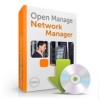Dell OpenManage Network Manager Web Client Guide 5.0 - Page 375
Simple Network Management Protocol. Network management protocol used, Simple Mail Transfer Protocol.
 |
View all Dell OpenManage Network Manager manuals
Add to My Manuals
Save this manual to your list of manuals |
Page 375 highlights
FILE LOCATION: Q:\CD_Stage\Apps_CD\DellNM50\docs\OMNM_5\Glossary.fm and a self-signed certificate does not provide any guarantee concerning the identity of the organization that is providing the website. SMTP - Simple Mail Transfer Protocol. SNMP - Simple Network Management Protocol. Network management protocol used almost exclusively in TCP/IP networks. SNMP provides the means to monitor and control network devices, and to manage configurations, statistics collection, performance, and security. SPANNING TREE PROTOCOL (STP) - The inactivation of links between networks so that information packets are channeled along one route and will not search endlessly for a destination. SSH (SECURE SHELL) - A protocol which permits secure remote access over a network from one computer to another. SSH negotiates and establishes an encrypted connection between an SSH client and an SSH server. SSL (SECURE SOCKETS LAYER) - A program layer created by Netscape for managing the security of message transmissions in a network. Netscape's idea is that the programming for keeping your messages confidential ought to be contained in a program layer between an application (such as your Web browser or HTTP) and the Internet's TCP/IP layers. The "sockets" part of the term refers to the sockets method of passing data back and forth between a client and a server program in a network or between program layers in the same computer. TRAP (SNMP TRAP) - A notification from a network element or device of its status, such as a server startup. This notification is sent by an SNMP agent to a Network Management System (NMS) where it is translated into an event by the Mediation Agent. TRAP FORWARDING - The process of re-emitting trap events to remote hosts. Trap Forwarding is available from the application through Actions and through the Resource Manager. VLAN - A virtual local area network (LAN), commonly known as a VLAN, is a group of hosts with a common set of requirements that communicate as if they were attached to the Broadcast domain, regardless of their physical location. A VLAN has the same attributes as a physical LAN, but it allows for end stations to be grouped together even if they are not located on the same network switch. Network reconfiguration can be done through software instead of physically relocating devices. DELL CONFIDENTIAL - PRELIM INARY 5/23/12 - FOR PROOF ONLY Template Last Updated - 7/01/2005 | Glossary 375















